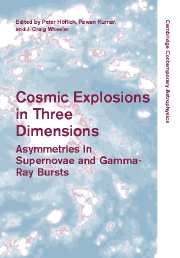Book contents
- Frontmatter
- Contents
- Part I Introduction
- Part II Supernovae: Observations Today
- 2 Supernova explosions: lessons from spectropolarimetry
- 3 Spectropolarimetric observations of supernovae
- 4 Observed and physical properties of Type II plateau supernovae
- 5 SN 1997B and the different types of Type Ic supernovae
- 6 Near-infrared spectroscopy of stripped-envelope supernovae
- 7 Morphology of supernova remnants
- 8 The evolution of supernovae in the winds of massive stars
- 9 Types for the galactic supernovae
- Part III Theory of Thermonuclear Supernovae
- Part IV Theory of Core Collapse Supernovae
- Part V Magnetars, N-Stars, Pulsars
- Part VI Gamma-ray Bursts
- Part VII Conference Summary
- References
4 - Observed and physical properties of Type II plateau supernovae
Published online by Cambridge University Press: 11 August 2009
- Frontmatter
- Contents
- Part I Introduction
- Part II Supernovae: Observations Today
- 2 Supernova explosions: lessons from spectropolarimetry
- 3 Spectropolarimetric observations of supernovae
- 4 Observed and physical properties of Type II plateau supernovae
- 5 SN 1997B and the different types of Type Ic supernovae
- 6 Near-infrared spectroscopy of stripped-envelope supernovae
- 7 Morphology of supernova remnants
- 8 The evolution of supernovae in the winds of massive stars
- 9 Types for the galactic supernovae
- Part III Theory of Thermonuclear Supernovae
- Part IV Theory of Core Collapse Supernovae
- Part V Magnetars, N-Stars, Pulsars
- Part VI Gamma-ray Bursts
- Part VII Conference Summary
- References
Summary
Abstract
I use photometry and spectroscopy data for 24 Type II plateau supernovae to examine their observed and physical properties. This dataset shows that these objects encompass a wide range in their observed properties (plateau luminosities, tail luminosities, and expansion velocities) and their physical parameters (explosion energies, ejected masses, initial radii, and 56Ni yields). Several regularities emerge within this diversity, which reveal (1) a continuum in the properties of Type II plateau supernovae, (2) a one parameter family (at least to first order), (3) evidence that stellar mass plays a central role in the physics of core collapse and the fate of massive stars.
Introduction
Type II supernovae (SNe II, hereafter) are exploding stars characterized by strong hydrogen spectral lines and their proximity to star forming regions, presumably resulting from the gravitational collapse of the cores of massive stars (MZAMS > 8 M⊙). SNe II display great variations in their spectra and lightcurves depending on the properties of their progenitors at the time of core collapse and the density of the medium in which they explode. Nearly 50% of all SNe II belong to the plateau subclass (SNe IIP) which constitutes a well-defined family distinguished by 1) a characteristic “plateau” lightcurve (Barbon et al. 1979), 2) Balmer lines exhibiting broad P-Cygni profiles, and 3) low radio emission (Weiler et al. 2002).
- Type
- Chapter
- Information
- Cosmic Explosions in Three DimensionsAsymmetries in Supernovae and Gamma-Ray Bursts, pp. 43 - 49Publisher: Cambridge University PressPrint publication year: 2004
References
- 1
- Cited by



